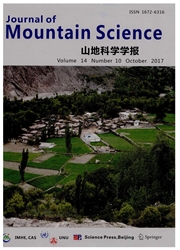

 中文摘要:
中文摘要:
尽管 TM 的学习(Thermo -Mechanics), HM (水力的力学) 和在装载测试下面联合的 THM (Thermo 水力的力学) 在开发中,在联合并且卸掉的 THM 下面的岩石失败分析是一个新兴的话题。基于卸掉的高温度 triaxial 渗出为 phyllite 的测试,这篇论文在 HM 下面讨论变丑和 phyllites 的失败机制, TH, TM 有卸掉条件的不完全的联合模型。结果显示有弹性的模量和起始的渗透减少和泊松比率与增加温度增加;有增加的有弹性的模量减少和泊松比率和起始的渗透增加浇压力。在卸掉的过程期间,岩石穿透性在起始的有弹性的变丑阶段是小的,但是穿透性在有弹性的变丑阶段的结束附近增加;包含温度和水压力的机制不同地影响穿透性。Phyllite 失败从岩石材料的起始的热损坏发生,切开并且弄软(它被毛孔水压力引起) ,并且从装载被形成的压力差别轴的压力并且卸掉限制压力。phyllite 失败机制是 transtensional (砍的紧张) 失败。
 英文摘要:
英文摘要:
Although the study of TM(Thermo Mechanics),HM(Hydraulic-Mechanics) and THM(Thermo-Hydraulic-Mechanics) coupling under a loading test have been under development,rock failure analysis under THM coupling and unloading is an emerging topic.Based on a high temperature triaxial unloading seep test for phyllite,this paper discusses the deformation and failure mechanism of phyllites under the "H M,T→H,T→M" incomplete coupling model with unloading conditions.The results indicate that the elastic modulus and initial permeability decrease and the Poisson's ratio increases with increasing temperature;the elastic modulus decreases and the Poisson's ratio and initial permeability increase with increasing water pressure.During the unloading process,rock penetrability is small at the initial elastic deformation phase,but the penetrability increases near the end of the elastic deformation phase;mechanisms involving temperature and water pressure affect penetrability differently.Phyllite failure occurs from the initial thermal damage of the rock materials,splitting and softening(which is caused by pore water pressure),and the pressure difference which is formed from the loading axial pressure and unloading confining pressure.The phyllite failure mechanism is a transtensional(tension-shearing) failure.
 同期刊论文项目
同期刊论文项目
 同项目期刊论文
同项目期刊论文
 期刊信息
期刊信息
